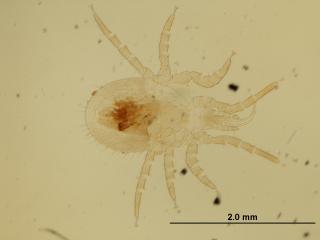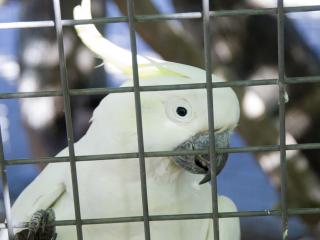Fleas
There are several species of flea in Western Australia (WA) which feed on the blood of warm-blooded animals, including humans. These small wingless insects have long legs which enable them to jump up to 300mm to reach a host. Fleas can transmit disease and the best known example is the plague, spread by the rat flea. Fleas, however, are not generally associated with disease transmission in Australia, although they can be responsible for the spread of tapeworm in pets and in humans. Animals being treated for fleas should also be treated for tapeworm.
Detection
Regularly check a pet’s belly and necks for signs of flea activity. If fleas are not obvious comb the pet’s fur with a lice comb at the base of the tail and wipe the comb on a piece of white moist tissue. Fleas consume relatively large amounts of blood and if the tissue stains red, it is a sign of fleas.
Flea allergy dermatitis (FAD)
Apart from flea bites, cats and dogs can suffer secondary symptoms caused by a hypersensitivity to flea saliva.
The most affected areas on the host are those where most fleas locate and feed. These are the back, inner thighs and lower abdomen. The affected animals display discrete crusted papules in these areas, causing discomfort. The scratching, biting and rubbing exacerbate the dermatitis. Instigate a thorough flea control program.
Control of fleas
The objective of flea control is to break the flea’s life cycle. This involves the simultaneous elimination of adult fleas on the host, along with adult fleas and the various immature stages in the indoor and outdoor environment. This is done with a range of chemicals which act in different ways.
Carefully follow label instructions. Overexposure may result in cumulative toxicity when the premises are treated. For pets other than cats and dogs, veterinary advice should be sought as some products can harm or kill pets, particularly rabbits. Cats can be very sensitive to some flea insecticides.
Thoroughly vacuum and clean the indoor premises and outside lairs and wash pet bedding in hot water prior to applying an insecticide.
Knock-down chemicals
These chemicals come in a range of products including sprays, powders, shampoos and tablets which are applied to the animal and their habitats.
Read the label to match the product to your particular requirements. Diazinon is highly toxic to birds and isnot recommended for treatment around ducks, chickens or other birds.
The highest flea populations are found where animals sleep or where they spend a lot of time. Fleas survive in cracks and crevices in the floor or in the structure of their quarters. Treat these areas with recommended knock-down chemicals.
Use at least two applications of insecticidal sprays because the immature stages of the flea are not vulnerable to treatment. Apply the second treatment 10 days (in hot weather) to 14 days (cooler weather) after the first. Do not contaminate animal drinking vessels, food containers or fish ponds with insecticide residues.
Treatments
A range of insecticidal collars are effective, but they need to be replaced regularly. Their active life depends on the chemicals and the length of the animal’s fur; being less effective on long-haired animals.
Treatments for pets come as dermal spot treatments or tablets. Although expensive, these chemicals are effective and last for four to six weeks and also control the egg and larval stages.
Space treatments
Entire rooms can be sealed and treated with specialised 'flea bombs'. These contain an insecticide combined with insect growth regulators, and can provide extended periods of control with a single treatment.
Chickens
Chickens are affected by so called ‘stickfast’ fleas. These occur in summer and autumn and infest the birds around the comb and eyes.
The application of non-burning oils such as petrolium jelly (Vaseline) or neatsfoot oil, smeared on the affected parts, may be used to treat stickfast fleas on chickens. Always consult a qualified veterinarian for specific advice when treating fleas on any avian poultry species.
In chicken pens, a clean concrete floor under roosts will drastically reduce the survival of fleas and other pests.
Ticks
Ticks are blood-sucking external parasites. Female ticks grow to 25mm long when fully engorged. They are usually reddish-brown and firm, and resemble tough, leathery sacs of fluid. Ticks are not insects but are arachnids, like spiders and mites. In south-western Australia the main ticks affecting pets and people are the kangaroo tick, Amblyomma triguttatum, and the brown dog tick, Rhipicephalus sanguineus. The term pepper tick refers to the smaller, young nymphal ticks.
Detection and life cycle
Ticks are usually visible on the host, where they embed themselves with their barbed mouthparts while feeding. Ticks develop through a series of moults and have four stages of development: egg, larva, nymph and adult. Adults usually mate on the host and will leave the host when fully engorged. The female will then rest for a while prior to laying thousands of eggs before dying. These parasites can survive many months between feeding, at any stage of development.
Upon hatching from the egg, the six-legged larval tick climbs onto foliage at the side of an animal trail or path from where it can transfer to a passing animal or person when they brush against the foliage. They feed on the host for several days before dropping to the ground. The larva digests the blood meal, then moults to an eight-legged nymph and repeats this process to find a host. It will then engorge itself, drop to the ground, then moult into an adult tick.
Ticks are found more commonly on dogs than on cats, especially if dogs exercise in bush areas with prominent wildlife such as kangaroos. The most commonly infested sites are the head, neck and ears; these being less accessible areas for scratching and grooming. On humans they are most often found in areas where clothing is tight on the body such as sock lines and waistbands, as well as around the collar.
Ticks can produce some inflammation of the skin and possible allergic reactions at feeding sites. Heavy infestations on pets and livestock can lead to anaemia, although this is rare. Medically important complications involving ticks include tick-typhus, Q-fever and tick-bite paralysis. However, these conditions do not normally occur in southern WA. If sickness, lethargy or slight paralysis occurs seek immediate medical or veterinary attention.
Tick control and removal
The life cycle of a tick roughly resembles that of fleas. Long term treatments for fleas can also control ticks on your pets and ‘tick collars’ are also available for dogs.
It is not possible to eliminate ticks from natural bush areas. On private property tick infestations can be reduced by keeping grasses short and by pruning shrubs along pathways to avoid direct contact with foliage. Private property can be fenced to prevent access by kangaroos and hence prevent the introduction of ticks onto the property.
If a tick is found attached to you or your pet, suffocate the tick with petroleum jelly (Vaseline). This may make the tick withdraw, mouthparts and all, from the wound before dying. Ideally it is best to use a pair of fine-pointed tweezers and at the skin level (without squeezing the tick’s body), carefully lever out the tick. If some of the tick’s mouthparts break off and remain in the wound they should be removed and the wound disinfected to prevent a secondary infection.
Bush tick
The bush tick, Haemaphysalis longicornis, was first detected in WA in 1983 on cattle at Walpole. Ticks are occasionally now found in Harvey where cattle have been sent from the Walpole area for many years. In most west coast, and inland areas, the bush tick is unlikely to establish as conditions are too hot and dry during summer.
Mites and lice
Mites and lice on dogs and cats are generally not a problem in WA and can be controlled using methods similar to flea elimination.
Mites and lice are common pests of chickens. It is essential to treat the environment, particularly any crevices in the floors and walls of roosts and coops.
Treat with chemical dusts or sprays, following label instructions.
Pests in aviaries
In WA home gardens, aviaries are affected by rodents, insects and feral birds, which can spread parasites and bacterial and fungal diseases.
Mice and rats are attracted to bird food and can contaminate food containers with their excretions. Exclude rodents from the aviaries by surrounding the base of the aviary with a galvanized iron sheet. This should be 300mm above ground and dug in 300–600mm. A concrete floor will prevent the rodents digging into the aviary. If any rodent manages to get in they can be controlled using traps situated in bird proof boxes within the cages. To avoid rodents keep the outside of the aviaries clean of food scraps. Hanging feed dispensers rather than floor or wall mounted will help to discourage rodents. Install traps and poison in bird proof boxes outside the aviary. Some aviary owners keep a resident guinea pig in the aviary to deter rats and mice.
Insects can also be transmitters of diseases and parasites. In WA ants and cockroaches are the most common insect pests in aviaries, apart from mites, ticks and fleas. If required, an application of a registered surface spray should control most insects (consult with your chemical retailer, hardware or pet shop).
It is also important to avoid aviary birds being in contact with wild birds. Double wire on the outside will make predation by wild birds more difficult as some can attack through single wire. Wild birds are often transmitters of internal parasites (for example, intestinal worms) or air sac mites, Sternostoma tracheacolum.
The popular gouldian finches and canaries are particularly susceptible to air sac mites. A clinical sign of air sac mites is open mouth breathing, which has a characteristic clicking sound. In a heavy infection some birds can be observed gasping for air. Other signs include coughing, nasal discharge, tail bobbing, weakness and weight loss. If your birds are affected, consult your local veterinary for treatment.
Unfamiliar pests
The Department of Agriculture and Food, Western Australia (DAFWA) is on the lookout for animal and plant pests, diseases and weeds that could pose a threat to agriculture and the environment.
If you discover something unfamiliar, please send a photo to the Pest and Disease Information Service (PaDIS) by email: info@agric.wa.gov.au or phone them on Freecall: 1800 084 881.
Please read the sending specimens for identification web article before sending, or bringing in, samples to the Pest and Disease Information Service, 3 Baron-Hay Court, South Perth, 6151, WA.




